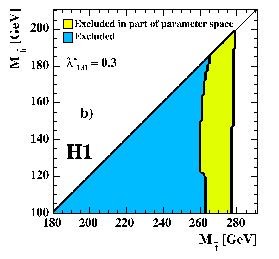This paper follows on from a previous H1 search for squarks in R-parity violating supersymmetry, which is explained here . In contrast to the earlier publication, in this paper we consider the scenario in which the supersymmetric top quark (stop) is heavier than the supersymmetric bottom quark (sbottom). The physical process for which we search involves the resonant production of the stop via the fusion of the beam positron with a quark from the proton, dominantly a down quark for large Bjorken-x or stop mass (e+ d -> stop). The stop then decays either in the same way as it was produced (stop -> e+ d), or `bosonically' to a sbottom and a W boson (stop -> sbottom W).
The bosonic stop decay is particularly interesting in light of the previous observation by H1 of an anomalously large yield of events with an isolated electron or muon, missing transverse momentum and a hadronic system with large transverse momentum (for details see here ). This final state topology could be explained by the bosonic stop decay mode with the W decaying to the isolated lepton and a neutrino for the missing transverse momentum and the hadronic system arising from the sbottom. In such an interpretation, one might expect to find related signals in other possible stop decay modes, such as the bosonic decay mode with the W decaying to a pair of quarks (two high transverse momentum jets) or the direct decay to a positron and a down quark.
 In fact, only the events with isolated muons and missing transverse momentum
survive the stop interpretation. No significant signal is seen in any other
channel, so bosonic stop decays are unlikely as an explanation of the
previously reported anomalous events. Since this is the case, the results
of the search are used to set limits on the stop mass, the sbottom mass and
the R-parity violating Yukawa
coupling of a down quark, a positron and a stop quark.
An example can be seen in the figure, where the
excluded regions of stop and sbottom masses are shown for a
coupling of electromagnetic strength. Stop quarks with masses up to 260 GeV
are excluded for all considered choices of other SUSY parameters. In at least
some parts of the parameter space, masses as large as 275 GeV are excluded.
These are the first such constraints from any experiment for the case where
the stop decays bosonically.
In fact, only the events with isolated muons and missing transverse momentum
survive the stop interpretation. No significant signal is seen in any other
channel, so bosonic stop decays are unlikely as an explanation of the
previously reported anomalous events. Since this is the case, the results
of the search are used to set limits on the stop mass, the sbottom mass and
the R-parity violating Yukawa
coupling of a down quark, a positron and a stop quark.
An example can be seen in the figure, where the
excluded regions of stop and sbottom masses are shown for a
coupling of electromagnetic strength. Stop quarks with masses up to 260 GeV
are excluded for all considered choices of other SUSY parameters. In at least
some parts of the parameter space, masses as large as 275 GeV are excluded.
These are the first such constraints from any experiment for the case where
the stop decays bosonically.